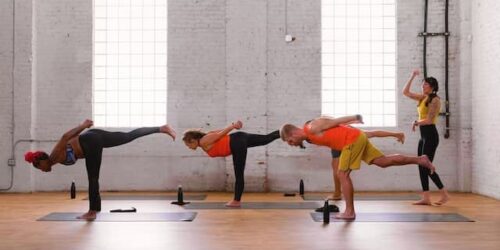How To Compass Pose? What’s The Benefit?
Compass pose, or Parivrtta Surya Yantrasana, is one of the more intricate and difficult yoga poses that has grown in popularity because of its health advantages. The shoulders, side body, and hamstrings are all worked out in this challenging pose.
Do not be afraid to attempt this pose just because it appears to be impossible. It might seem impossible at first, but with time and effort, things will start to improve. Along with that, the pose’s advantages are too great to ignore. To execute this pose, you must be persistent and dedicated.
So without further ado, let’s learn more about the compass pose.
Table of Contents
How to Do Compass Pose
Compass pose does not require any special tools other than a yoga mat. The compass pose is demonstrated in this manner.
- Cross your legs comfortably as you sit.
- Take a deep breath in and hug your right knee close to your chest. You can either keep your left leg extended in front of you or bend it slightly.
- your left hand as you raise your right leg. Right fingertips should be on the floor outside of your right hip as you pass your right arm through your right knee.
- As you assume this position, breathe slowly and steadily while concentrating on sitting up straight, lengthening your spine, and remaining upright.
- Place your right knee as high up on the right arm as you can using your left hand. You want your right leg straight and your right knee to be behind your right shoulder.
- Bring your left hand to the outside of your right foot.
- Stretch your left arm back behind your head and start to straighten your right leg.
- While maintaining your upright posture, look up toward your left arm.
- As you maintain this position, take three to five full breaths.
- Exhale slowly as you carefully come out of the pose, guiding your right leg back down with your left hand as you switch to the other side.
Tips and Techniques for Compass Pose
While completely stretching your side body, hamstrings, and hips, compass poses can be a little challenging. Here are some techniques and tips to help you achieve this pose safely.
- Breathing in a controlled manner is essential to performing any yoga pose. Make sure your breathing is controlled while performing the compass pose.
- If your pose differs from that of the others, do not worry. Encourage your body to perform better while avoiding overexertion. Keep in mind your body’s limitations.
- Warm up prior to performing this pose. Pose variations like chair pose, half moon pose, downward dog, and others will assist you in stretching and getting ready for the compass pose. Your body will be easier to position for the pose.
Benefits of Compass Pose
Physical Benefits
Stretching through the hamstrings and groin in positions like half or full splits, Heron Pose or supine hamstring stretches is necessary to get the body ready for Compass Pose. These muscles can be lengthened to help with lower back pain relief and to promote more fluid movement in the lower body.
By performing Happy Baby, Lizard Pose, and Twisted One-Legged Dog regularly, you can develop the hip opening required to enter this pose’s full expression.
There are over 20 muscles that cross the hips, which is why hip openers are so beneficial to us. We can perform everyday tasks more easily (like squatting to pick something up off the floor) and are less likely to overuse and strain our backs by lengthening these muscles.
Gate Pose, Bound Half Moon Pose, and Revolved Seated Wide Angle Pose can all be used to increase oblique length and shoulder mobility. The obliques can rotate and move more freely by being lengthened. Better posture and alignment are produced throughout the entire body as a result. Releasing tension in the shoulders can help with stress and tension headaches, as well as improve posture in general.
Mental Benefits
The most valuable lessons, as with all yoga postures, are learned along the way rather than by perfecting an asana the first time. The difficulty of assuming the Compass Pose teaches us to be extremely patient because it may take many months (or even years) to find enough space to assume the posture’s final expression with the leg fully extended and the spine rotated.
The present moment is all we truly have, and as we slowly work to get our bodies ready for this pose, we are reminded of this. No amount of pushing and forcing will make our body open any faster, just as no amount of wishing or hoping will make things move forward in other areas of our lives.
The journey to Compass Pose, therefore, serves as a gentle reminder that it is consistent action, no matter how small, that actually aids us in achieving our objectives.
Spiritual Benefits
When we focus on each yoga pose on the mat, it encourages us to examine our spiritual selves.
However, difficult postures frequently call for even deeper spiritual reflection because they force us to confront our shadow selves when problems arise. On the path to opening the body enough for Compass Pose, we are challenged to look at our lack of tolerance, propensity for comparison, and possibly even our self-talk.
When performing physical poses, such as Compass, one can experience similar energetic changes. Extreme hip opening frequently promotes the release of uncomfortable and unexpressed emotions, which can initially be unsettling.
Nevertheless, making room in this area can assist us in beginning to let go of our need for total control over our lives, allowing for more freedom of expression and creativity.
Compass Pose’s greatest ability is to teach us complete acceptance. We may eventually have to come to terms with the possibility that our unique body type will never fully express the Compass Pose and learn to accept that.
In the end, what matters are the lessons we discover about ourselves along the way to the shapes, not the shapes themselves.

Common Mistakes
People frequently try to push themselves too hard too soon in the compass pose because it is an advanced pose. Pay attention to your body’s cues and stop if you experience any pain.
Be kind to yourself and give yourself time to get the hang of this pose. You’ll succeed if you keep at it and practice. Just don’t try to rush things. The most frequent errors are explained in the following.
Rolling Your Weight Backward to Achieve the Pose
It’s a common mistake to try to “make room” or to sneak your knee behind your shoulder by rolling your weight back onto your tailbone, causing your spine to round forward. This throws your body out of alignment and negates the beneficial effects the pose is intended to have on your alignment and posture.
If your hamstrings, hips, and shoulders haven’t developed enough flexibility, you’ll make this error. Back off the pose and try a similar one like the heron pose that is intended to increase hip and hamstring flexibility.
Forcing the Pose
While it’s important to push yourself during yoga practice, it’s never a good idea to push your body beyond its current capacity. It’s easy to get hurt by forcing the pose and pushing past the point of stretch to the point of pain or discomfort.
When attempting the pose, push yourself just enough to feel a light stretch; however, if you find it difficult to maintain the stretch, you’ve gone too far. To successfully modify the pose, bend your knee or grab a yoga strap.
Safety and Precautions
The most important thing to keep in mind when practicing advanced yoga poses like the compass pose is that success takes time and effort. Move slowly and give your body time to acquire the flexibility required to achieve the full expression of the pose.
Injury is a given when you push your body beyond its current capacity. You’re pushing yourself too far if you can’t hold a stretch for more than a second or two without experiencing pain. Retract your steps and carefully build up to the pose using the necessary adaptations.
Close Note: Worth a Try
Compass pose has many advantages, so you should definitely give it a try. Continue to try even though it will take some time and patience. It’s crucial to move forward gradually while performing such challenging poses in order to achieve maximum flexibility.





